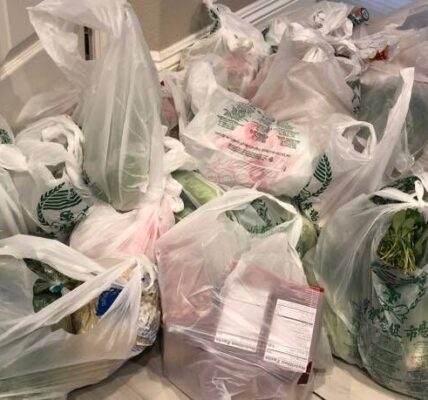Every parent knows that moment — when a peaceful grocery trip suddenly turns into a chorus of “Can I have this?” “Please, just one!” or “But I really want it!” From candy to cereal to toys stacked by the checkout line, the aisles become a battleground of willpower.

For one young mother, those weekly shopping trips had become emotionally draining. She loved her kids deeply — their energy, their curiosity, their big, bright eyes — but by the time she got to the car, her patience often ran thin. “I was just so tired of saying no,” she said. “Every aisle was another chance for them to ask for something. And every time, I felt like the bad guy.”
Then one day, something changed. It wasn’t planned or complicated. It started with one small idea — an idea that would not only transform their grocery trips but also plant something much deeper in her children’s hearts: empathy.
A Small Idea That Changed Everything
That afternoon, as she was preparing her shopping list, her eyes caught sight of a flyer near the door — a reminder that the local food bank was running low on supplies. Something clicked.
“What if,” she thought, “instead of saying no all the time, I give them something to say yes to?”
The next morning, she loaded her 2-year-old and 4-year-old into the car. They were already buzzing with excitement, imagining the snacks and sweets they might get. But as they entered the store, she smiled and said gently, “Okay, today you each get to pick one can of food — but it’s not for us. It’s for someone who needs it.”
At first, her oldest looked puzzled. “What do you mean, Mommy?”
She knelt down and explained, “There are families who don’t have enough food. The food bank helps them. So, we’re going to help, too. You can choose any can you want — something you’d like to give.”
The little girl’s eyes widened. “Any can?”
“Any can,” her mother said.

The Joy of Choosing
What happened next surprised her. The children didn’t complain. They didn’t ask for toys or treats. Instead, they began thinking. They walked slowly down the aisles, touching each can, reading labels (or pretending to), whispering to each other like they were making an important decision.
Her daughter picked up a can of peaches and held it to her chest. “These are sweet. I think someone would like these.”
Her son, still small and serious, chose a can of chicken soup. “This one helps when you’re sick,” he said solemnly.
The mother watched quietly, heart swelling. For the first time, the grocery store wasn’t about what they could get. It was about what they could give.
When they reached the checkout, the children carried their cans carefully, holding them like treasures. The cashier smiled as they placed them on the counter, announcing proudly, “These are for the food bank!”
And when they dropped the cans into the donation bin by the door, something beautiful happened — they both beamed with pride.
A New Kind of Routine
The next week, they did it again. And again after that.
“Now, they remind me,” the mom laughed. “As soon as we walk in, they say, ‘Can we pick our can for the food bank?’”
It became their little ritual — one that transformed grocery shopping from a test of patience into a quiet lesson in compassion.
Five trips later, she realized something astonishing. Not once had they asked for toys, candy, or treats. Not once had there been tears or begging at the checkout line.
Instead, there was focus, joy, and pride — the kind that comes from doing something good, even in small ways.
“They think really hard about which can to choose,” she said. “They carry it themselves, hand it to the cashier, and make sure it goes in the donation bin. They even tell people what the food bank is now.”
Her daughter often explained it to strangers in the sweetest way possible: “It’s a place where people can get food if they don’t have any.”
Planting Seeds of Kindness
What this mother discovered is something simple yet profound — children want to feel capable. They want to make choices that matter. By giving them the power to help, she gave them a purpose bigger than themselves.
It wasn’t about discipline or distraction. It was about connection.
“I know this won’t last forever,” she admitted, smiling. “They’ll grow up, and one day, this little tradition might fade. But for now, it’s teaching them that giving can be joyful. And that’s something I hope stays with them.”
The Ripple Effect
What began as a small parenting hack quickly turned into something more. Neighbors noticed the children carefully carrying their cans each week. One woman smiled and said, “You’ve got the kindest little helpers I’ve ever seen.”
Before long, others started doing the same. A father in line handed his son a can of beans. A grandmother let her granddaughter choose a can of soup. It spread — one small act of generosity multiplying quietly across the community.
“That’s the part that gets me,” the mom said. “It started as a trick to make shopping easier. But now, it’s teaching them empathy — and inspiring other people too.”
Even the store employees noticed. “Those kids made our day,” one cashier said. “They remind us what kindness looks like.”
More Than Just a Trick
Of course, it’s not a perfect system. There are still days when the kids get tired, when the cart is full and patience runs thin. But even then, the ritual remains.
“Sometimes they argue over who gets to drop the can in the bin,” the mom said, laughing. “But that’s a problem I don’t mind having.”
She’s already thinking of ways to grow the idea as her kids get older. “Maybe when they start reading, we can make it a game — like ‘Find a can that starts with the letter C,’ or ‘Find something that helps people stay healthy.’ I just want them to see that giving can be fun, not forced.”
It’s a lesson as timeless as it is simple: generosity begins in the smallest moments.
The Heart of It All
In a world where children are constantly told to want more — more toys, more screens, more sweets — one mom found a way to teach the opposite. She showed them the quiet happiness of giving something away.
The grocery store, once a place of frustration, became a classroom. The lesson wasn’t written on a board or taught from a book. It was lived, can by can, week by week.
It wasn’t about what they took home.
It was about what they left behind — a little hope for someone else, and a little light inside themselves.
Now, every time that mom watches her children skip toward the donation bin, she feels something stir — gratitude. Gratitude that in a world so full of noise, she found a way to teach them something that truly matters.
“I thought I was teaching them to be kind,” she said softly. “But really, they’re the ones teaching me.”
And that’s the beauty of it. Kindness doesn’t need grand gestures or perfect moments. Sometimes, it starts with one small idea — a can of soup, a child’s hand, and a mother’s quiet wisdom.
Because when we teach our children how to give, we give them something that lasts far beyond childhood:
the heart to see others, the courage to care, and the joy that comes from making the world just a little bit better — one grocery trip at a time.




